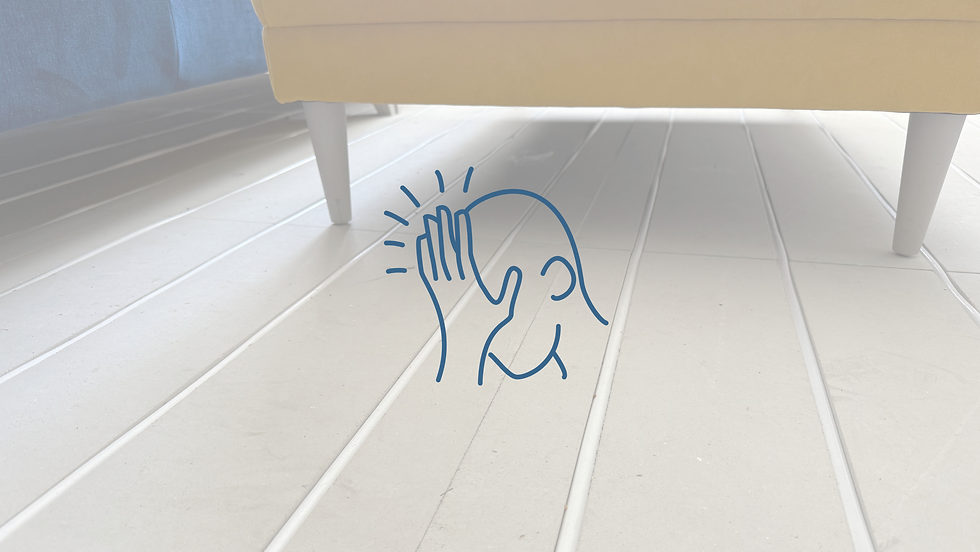Frequently Asked Questions (FAQ) About Underfloor Heating:
- The Underfloor Megastore

- Apr 8, 2024
- 4 min read

General Queries:
Do I require a special boiler?
No special boiler is necessary. Underfloor heating is compatible with your current boiler, whether it's gas, oil, LPG, or heat pumps. See our recent post about combi boilers here.
Which underfloor heating system is better, Water or Electric?
Typically, warm water underfloor heating systems (wet systems) are a bit more costly to install but cheaper to operate compared to electric systems. See our post on water or electric underfloor heating here.
How does a water underfloor heating system work?
Warm water is circulated through pipes beneath the floor. Heat rises, creating a comfortable environment in the room through the floor surface, whether it's suspended timber or concrete.
Is underfloor heating more efficient and cost effective than traditional radiators?
Yes, it can be up to 40% cheaper to run depending on your boiler. It offers better control and efficiency compared to traditional radiators. See our posts on energy efficiency here.
What is the warm up time and max temperature of underfloor heating?
The warm-up time varies based on floor coverings. Stone and tiles conduct heat efficiently, reaching temperatures up to 29°C, while carpet is less efficient, around 27°C. However, underfloor heating efficiently maintains a comfortable temperature for walking, sitting, or lying.
Can underfloor heating be used with different floor types?
Underfloor heating is compatible with various flooring types, from carpet to tiles, stone, wood, and even leather. Always check with the manufacturer for specific guidance.
Is underfloor heating suitable for bathrooms and conservatories/garden rooms?
Yes, it's a popular choice for these areas, including wet rooms, often complemented by heated towel rails. Underfloor heating can be used in every room!
Can underfloor heating be installed on upper floors of my home?
Absolutely, underfloor heating is suitable for upper floors as well as the ground floor. If you have water underfloor heating on your ground and first floor, you will require a manifold on both floors.
How should I operate underfloor heating? Should I leave it on constantly?
Underfloor heating operates at lower temperatures than radiators. It's generally recommended to leave it on constantly and regulate the temperature with the thermostat for efficiency. See our specific blog post here.
Retrofit Underfloor Heating
Is underfloor heating compatible with my existing heating system?
Yes, you can integrate underfloor heating into your current system, choosing specific areas or rooms for installation.
Is my property suitable for underfloor heating?
Most properties can accommodate underfloor heating. Newer houses typically meet insulation standards, while older ones can be retrofitted effectively.
Can I retrofit underfloor heating?
Retrofitting involves installing the system on top of the existing subfloor with minimal increase in floor height. This can be done with both electric and water underfloor heating.
Is my existing subfloor suitable for underfloor heating?
Most subfloors are suitable, and various designs are available for compatibility. Proper installation for a water system includes a damp-proof membrane, insulation layer, pipe work, and flooring. For electric we always recommend insulation before installing your heating mat or cable.
Will my floor height be effected when retrofitting underfloor heating?
Depending on your choice of system, some floors may raise by 10mm and some by 50mm.
Installation of underfloor heating
What size underfloor heating kit do I need?
The kit size depends on the area and number of rooms requiring heating. See our water and electric measuring guides for more information. See our how to measure guides here.
How do I calculate the size of my room for underfloor heating?
Calculate the square area of the room, excluding fixed furniture. Aim to cover 80-95% of free floor space to avoid cold spots. With electric underfloor heating, always deduct 10% from your room size when ordering your underfloor heating mat. See our how to measure guides here.
What are the installation costs?
Installation costs vary based on size and complexity. Larger or commercial projects may take longer to complete, however small bathroom installations can be complete for a low cost or DIY (Please note a qualified electrician should check and connect your heating mat)
Can I install underfloor heating myself?
Experienced DIYers can install it, but without a guarantee for the work, and insurance considerations may apply. Electric mats are the go to for DIYers, however we always advise that a qualified electrician should connect and test your heating mats. See our install guides here.
How do I design the layout?
Underfloor heating pipes are flexible, allowing for customization to fit various room shapes. Underfloor heating mats can be altered to suit room sizes (DO NOT CUT THE CABLE). We provide designs and quotes for underfloor heating here.
Maintenance of underfloor heating:
How long does an underfloor heating system last?
Our Underfloor heating pipes are guaranteed for 50 years and it is known for them to last longer than this. Underfloor heating cables are guaranteed to up to 25 years.
Does underfloor heating require maintenance?
Underfloor heating systems require minimal maintenance, and we offer ongoing support and advice to all of our customers. See our maintenance tips here.
Still have questions? Contact us today or give us a call.




Comments